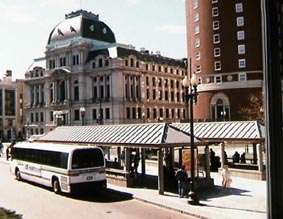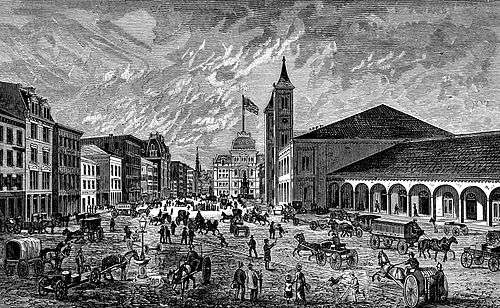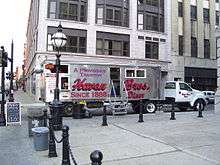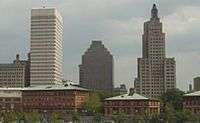Kennedy Plaza

Kennedy Plaza (formally City Hall Park, formally Exchange Terrace/ Exchange Place) is a rectangular shaped central plaza and the geographic center of the downtown Providence, Rhode Island area, it is situated between Providence City Hall and the Providence Federal Building. Following a traditional colonial pattern, the Plaza has served as a transportation hub since 1847.[1]
Today, Kennedy Plaza is bounded by Exchange Street ("Little Wall St."[2]) on the northeast, Fulton Street on the southeast, Dorrance Street on the southwest, and Washington Street on the northwest.
Surrounding the Plaza are Burnside Park, the Bank of America skating center, and the mobile Haven Brothers Diner which has been driven into the Plaza and parked next to City Hall nightly since 1893. On the east edge of the plaza sit the three buildings - One Financial Plaza; 50 Kennedy Plaza; Bank of America Building (Providence) - that comprise the famous Providence skyline.
Transportation hub
The Plaza has been the traditional transportation hub for much of its history, beginning with Pedestrian traffic and evolving into Horse and buggy to modern auto-cars. Kennedy Plaza serves as the modern nexus of the state's public conventional-bus and trolley-replica bus transit services operated by Rhode Island Public Transit Authority (RIPTA), as well as a departure point for Peter Pan and Greyhound bus lines. Greater Attleboro Taunton Regional Transit Authority (GATRA) commuter bus service between Taunton, Massachusetts and Providence also operates out of the Plaza in the morning and evening. Through RIPTA alone Kennedy Plaza serves over 69,000 people a day.[3]
During WWII, the United Electric Railway and The Narragansett Electric company(owned by Marsden J. Perry) put "trackless trolleys" into service by installing electric buses in 1943.[4] Employing what was then known as a “WAIT” station in the form of a loop, U.E.R buses served North Main St to Pawtucket and through the East Side tunnel to Thayer, Waterman, Angell, Hope, and Elmgrove Streets. As federal funds became available in the late 1970s for automobile-free zones, all local bus-waiting areas were consolidated to Kennedy Plaza.
2014 RIPTA hub rehabilitation project
In Summer 2014, RIPTA began a redesign effort that changed the configuration of Kennedy Plaza, and included the relocation of current bus stop terminus points formally located at the Plaza. The overall plan transformed the Plaza into a pedestrian oriented environment, where bus terminal locations were moved to the periphery of the Plaza and adjacent Burnside Park. RIPTA has noted an 11% increase in ridership of the Statewide system.[5]
In anticipation of the July 15, 2014 groundbreaking for the rehabilitation project, on July 12 going forward, Bus terminus locations were found along Exchange Street near One Financial Tower, North Fountain Street, Exchange Terrace along the Rhode Island Foundation Building, and on Sabin Street along the Rhode Island Convention Center, beneath the Omni Hotel Towers. RIPTA announced on December 9, 2014, that the Hub would reopen January 17, 2015.[6]
History
| “ | This is the city's most constantly reworked space, and fully interpreting its history would fill a book that could be a landmark in understanding American urbanism. | ” |
- -- Architectural historian William McKenzie Woodword, Guide to Understanding Providence Architecture
"In 1787 the China Trade began. Ships from Providence made their way to Batavia (present day Jakarta), Canton, India, and Japan bringing exotic easter goods home to Rhode Island."[7] This legacy of trade has influenced the development of Kennedy Plaza over the last three centuries. Lacking any water power, the early Industrial Revolution bypassed Providence [...] until George Henry Corliss developed his steam engine thus Providence investors realized [the Rhode Island invention] meant they could now get in on the Industrial Revolution, as it obviated the need for the water power that Providence lacked; investors lined up. The Industrial growth prompted Providence’s population to shift from the East Side, where the city was first settled to Weybosset Neck (today’s Downcity) on the west bank of the river where the city’s factories and housing for their workers would be built."[7]

Up to as late as 1889 the "Cove in Providence's" shores reached the eastern fringes of modern Burnside Park, and the train tracks covered much of what is Washington Street as the Old Union Train Station occupied the entire western half of the coming plaza.[7] Photographs from the period show a wide avenue stretching from the buildings along Fulton Street to about where the current middle island of the RIPTA facility stands today.
Providence is a "walking" city and Kennedy Plaza has seen many transformations; it was known as City Hall Park, Exchange Place, and Exchange Terrace. It was also referred to as "The Mall" until its modern name change. The open space sits east of the current Providence City Hall built in 1878, and has been used as park space, and a parking lot at the dawn of the automobile. The Plaza has not seen a ten-year period without salient change to its appearance. From 1847 to 1980, the northern edge was home to a "Old Union" train station where Burnside park currently exists.[1]
Kennedy Plaza has been the site of frequent events, demonstrations, petitions and orations in front of City Hall or the Court House.[1]
On April 20, 1861, at 10:30AM the sidewalks were filled with cheering throngs, who greeted volunteers, of the first division of the First Regiment of Detached Rhode Island Militia leaving for Washington, D.C.. Colonel Ambrose Burnside, in command, had ordered the men of the first division to assemble upon Exchange Place.[8] A second detachment left from the plaza on April 25, 1861.
Haven Brothers Diner (located next to City Hall during the evenings hours), founded in 1888, is one of the oldest restaurants on wheels in America when it was launched as a horse drawn lunch wagon.[9]
Crowds gathered at the Plaza when President Teddy Roosevelt spoke on the City Hall steps on August 23, 1902.
Mayor Joseph H. Gainer presided over a redesign of the Plaza during his administration (1913-1927).[10]

In 1914, due to the closure of European performance spaces during the World War, Harry Houdini brought his show to American audiences and to Kennedy Plaza. Over 20,000 people filled the Plaza, on March 7, to watch him perform his new act in "a straitjacket escape made while dangling high in the air, upside down" hanging from the fourth floor of the "Evening News" Building formerly sited at 50 Kennedy Plaza. The crowd filled the plaza expanse following Fulton Street.[11][12] In 1917, Houdini returned to Kennedy Plaza to perform his escape act a second time, as "80,000 fedora-hatted folks who thronged the streets".[13]
"In 1916 Providence hosted a 6 1/2 hour World War I Preparedness Parade in response to President Woodrow Wilson's call for America to ready itself for war in Europe. A review stand for the parade was set up in front of City Hall, and 1,560 children, Civil War veterans and band members performed patriotic songs and shaped a gigantic "living flag" on a scaffolding above the front steps." [14]
On May 11, 1919, a World War I Victory Parade was held on Washington Street and Kennedy Plaza, that marched through what was a Victory Arch (in the center of the plaza), atop of which was a reproduction of the Hellenistic sculpture "Winged Victory of Samothrace (the Greek goddess Nike)." The inscription on the Victory Arch read: "TO THE MEMORY OF THOSE WHO WENT FORTH AND RETURNED NOT WHOSE SOULS ARE MARCHING ON."[15]
The Category 3 1938 New England Hurricane flooded the entire expanse of Kennedy Plaza when it made landfall on September 20. Afternoon weather conditions began to deteriorate rapidly on Long Island as well as along the southern New England coast. The storm made a second landfall still as a category 3 hurricane somewhere between Bridgeport and New Haven, Connecticut around 4:00pm with sustained winds of 115 mph.[16]
John F. Kennedy spoke on November 7, 1960, days before he was elected president.
In 1964, four years after the 1960 speech attended by 60,000 people by some accounts[17] the plaza was renamed in honor of the late US President John F. Kennedy.

In 2013, plans were unveiled to reduce traffic dissecting the plaza. As well as incorporating better transitions between the plaza’s regions, which includes eateries with outdoor seating and venues for outdoor entertainment. More trees, a water feature and a designated parking lot for food trucks is also part of the rehabilitation scheme.[18]


Famous speeches
- One of the features of the tremendous industrial development of the last generation has been the very great increase in private, and especially in corporate, fortunes. ... It is not true that the poor have grown poorer; but some of the rich have grown so very much richer that, where multitudes of men are herded together in a limited space, the contrast strikes the onlooker as more violent than formerly.
On the whole, our people earn more and live better than ever before, and the progress of which we are so proud could not have taken place had it not been for the up building of industrial centers, such as this in which I am speaking. But together with the good there has come a measure of evil.… Under present-day conditions it is as necessary to have corporations in the business world as it is to have organizations, unions, among wage-workers. We have a right to ask in each case only this: that good, and not harm, shall follow.[19]- Theodore Roosevelt (Republican President) "Trust" speech from steps of Providence City Hall toward crowd assembled on Kennedy Plaza[20][21] - 23 August 1902.
- On other occasions, in other years, this country has elected Republican Presidents and Democratic Presidents. They do it when they make a decision that that party and that candidate will serve a great national purpose. In my judgment and the responsibility ultimately is yours, in my judgment the United States will be best served by a candidate and a party who recognizes the basic issues of our time, and that is that this country has to go back to work again. [22]
- John F. Kennedy (Democrat candidate for President) speech from steps of Providence City Hall toward crowd assembled on Kennedy Plaza[20] - 7 November 1960, Senate Speech file of the John F. Kennedy Pre-Presidential Papers, John F. Kennedy Library.
Sculpture and public art
Kennedy Plaza is home to three public art works. The most prominent is the 1871 Soldiers’ and Sailors’ Monument[23] which occupies space directly in front of Providence City Hall. Dedicated originally in 1871, by architect Alfred E. Stone with sculptor-work by Randolph Rogers, it was moved during the City Hall Park/ Exchange Place transformation in 1913 to the center of the plaza, and returned to its present location in 1997. Large bronze plaques on the monument’s base list residents killed in the war.[23] Another plaque honors Rhode Island's African-American veterans.[23] A dedication on a northeastern plaque reads ”Rhode Island pays tribute to the memory of the brave men who died that their country might live.”[23]
A clock occupies space in front of the main doors of the RIPTA Intermodal Transportation Center.
The 1911 Providence copy of The Hiker (Kitson), is sculpture in the center island of the RIPTA facility berths, and commemorates the American soldiers who fought in the Spanish–American War, the Boxer Rebellion and the Philippine–American War. The original 1906 sculpture by Theo Alice Ruggles Kitson is located at the University of Minnesota.
Neighboring buildings and spaces (clockwise)
- Federal Building (Providence, Rhode Island)
- One Financial Plaza
- 100 Westminster (connected to 30 Kennedy Plaza)
- 50 Kennedy Plaza
- Bank of America Building (Providence)
- 66-68 Kennedy Plaza
- 70 Kennedy Plaza(People's Savings Bank)
- The Westminster Square Building (10 Dorrance Street)
- Haven Brothers Diner
- Providence City Hall
- Providence Biltmore (11 Dorrance St)
- Bank of America Skating Center (2 Kennedy Plaza)
- Burnside Park, Providence, Rhode Island
- Annex Finance Station Post Office, 2 Exchange Terrace
Rehabilitation and historic tax credit projects
- In 1975 the Providence Biltmore closed and remained out of use until a group of local businesses implemented Federal tax credits to rehabilitate the building, reopening it in 1979.
- High Rock Development proposed a plan to convert the shell at 111 Westminster Street into mostly luxury apartments, involving $80 million in tax credits from the State. This plan was rejected. The State has applied to move some of their Health and Human Services offices into the now vacant property. High Rock Development has since offered a four-year plan that would invest $40 million of new funding for the rehabilitation of the tower into a dense urban mix of uses that include retail, business and 285 residential units.[24] The former and new financing proposals were met with mixed reaction.
Greater Kennedy Plaza
Greater Kennedy Plaza is a partnership of private and public sector organizations that have come together to transform the downtown Providence area (including Burnside Park, The Providence Rink at the Bank of America City Center, Biltmore Park and Kennedy Plaza) into a lively public square, rich with activity.[25]
References
Woodword, William McKenzie. Guide to Understanding Providence Architecture. United States: 1st ed, 2003. ISBN 0-9742847-0-X. Pgs 97-98
- 1 2 3 "Ownership and Identity in Kennedy Plaza".
- ↑ "Exchange Place, Little Wall Street - Providence Public Library".
- ↑ "RIPTA Accomplishments in FY2006". Rhode Island Public Transportation Authority. Retrieved 2007-06-06. 25,296,132 boardings / 365 days = 69,304 daily.
- ↑ electric buses
- ↑ http://www.providencejournal.com/breaking-news/content/20140707-bus-stops-to-be-moved-out-of-kennedy-plaza-starting-saturday-to-allow-for-construction-poll.ece
- ↑ "RIPTA Announces January Reopening of Kennedy Plaza Transit Hub in Downtown Providence".
- 1 2 3 Nickerson, Jef (16 September 2011). "Notes from the PPS Symposium Morning Session".
- ↑ "Rhode Island Civil War Round Table".
- ↑ Seth Brown, Rhode Island Curiosities:Quirky Characters, Roadside Oddities, and Other Offbeat Stuff(Guilford, CT: Globe Pequot Press, 2007), ISBN 0-7627-4338-7
- ↑ Conley, Patrick T. "Rhode Island Hall of Fame Honorees: Six Legal Luminaries" (PDF). Rhode Island Bar Journal. Rhode Island Bar Association. 63 (May/June 2015): 27–30. ISSN 1079-9230. Retrieved 17 January 2016.
- ↑ "HARRY HOUDINI! MASTER MAGICIAN & PSYCHIC INVESTIGATOR".
- ↑ "GoProvidence on Twitter".
- ↑ Hoffman, Barbara (October 31, 2010). "Hang man". New York Post.
- ↑ "History of City Hall".
- ↑ "Office of the Secretary of State: Nellie M. Gorbea: Virtual Exhibits".
- ↑ http://www.weather.gov/okx/1938HurricaneHome
- ↑ "Downtown Providence Parks Conservancy - DPPC -".
- ↑ "Plaza Makeover Includes Better Public Transit".
- ↑ "Context of 'August 23, 1902: Roosevelt Advocates Federal Regulation, Oversight of Corporations'".
- 1 2 "Roosevelt Speech, 1902 by Granger".
- ↑ "TR Center - Server Error".
- ↑ "John F. Kennedy Speeches - John F. Kennedy Presidential Library & Museum".
- 1 2 3 4 "Soldiers' and Sailors' Monument, Providence, R.I.". 23 Aug 2010.
- ↑ "'Superman' developer alters bid for state aid".
- ↑ "Visit & Events - Downtown Providence Parks Conservancy - DPPC".
External links
| Wikimedia Commons has media related to Kennedy Plaza. |